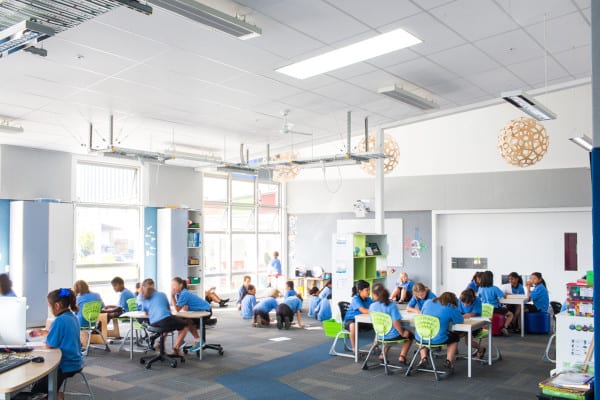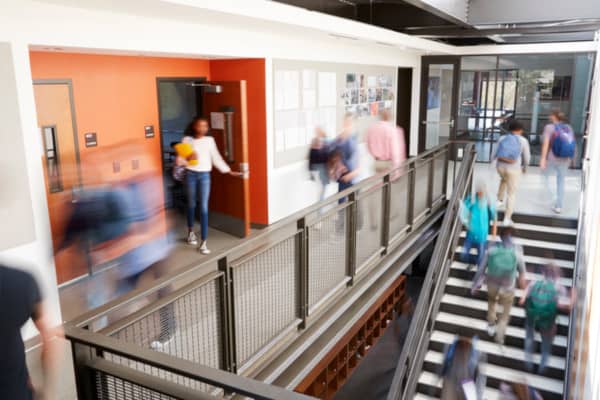Learn the school fire safety requirements outlined in NFPA model codes
One of the greatest fire tragedies in U.S. history happened in a school. The year was 1958, and the building lacked the fire protection features that make strong fire safety in schools commonplace today:
It had no sprinkler system or smoke detectors. The two fire alarms weren’t connected to the local fire station, and neither was located in the part of the school where the fire started. Fire extinguishers were stored in wall wells seven feet above the floor that most adults couldn’t reach.
The school’s interior was almost entirely made of combustibles—everything from the stairs to the floors to the walls were constructed of wood. The floors had been recoated many times with flammable petroleum-based waxes. The roof wasn’t vented and had been repeatedly sealed with tar paper, causing it to burn faster. Fire doors only protected part of the second floor—and they were propped open to enable students to easily pass during the school day. The other staircases were open, with nothing to hinder the spread of the fire.
The fire started in a barrel of oily rags in the basement level of the two-story building. As the fire grew and the smoke worked its way through the stairs and cracks in the wood floor, teachers and students on the first level made their way out. The fire alarm didn’t work when it was tripped, and by the time the second-floor occupants were aware of the incident, they were out of time. Panicked students tried to get out any way they could, including jumping out of the windows. In total, 92 children and three adults were killed in the Our Lady of Angels school fire.
The tragedy resulted in widespread fire safety reforms and code updates governing schools. Today, schools are much safer; the National Fire Protection Association (NFPA) reports that between 2013-2017, school fires accounted for an annual average of “one civilian death” and “42 civilian injuries.” The most common losses in school fires are financial, representing about $42 million per year in damage. These fires are most often caused by arson and account for more than 3,000 fire department responses annually.
The relative lack of injuries and fatalities that we experience in U.S. school fires stems from the modern fire protection codes and standards that have been developed and enforced in these occupancies. Codes for educational occupancies in most states and jurisdictions are based on the model codes created by NFPA. Specifically, chapter 14 of NFPA 101: Life Safety Code outlines the minimum fire protection and life safety requirements for educational occupancies.
NFPA 101 defines educational occupancies as any building “used for educational purposes through the twelfth grade by six or more persons for 4 or more hours per day or more than 12 hours per week” (6.1.3.1). This definition is expanded to include all preschools and kindergartens that meet specific criteria:
(1) The purpose is primarily educational, even though the children who attend such schools are of preschool age.
(2) The children are all 24 months of age or older.
In essence, if a school has six or more students between 24 months old and various ages in the 12th grade, NFPA rules apply. Here are the major NFPA requirements for life and fire safety in schools:
School facilities and space requirements
The first step in determining code requirements involves assessing the capacity of the facility. This is accomplished by calculating the occupant load of the space—how large the area needs to be based on the potential number of people in the school (NFPA 101: 7.3.1.2). The code requires at least 20 square feet per person.
For example, if a school has 50 students and staff, it needs a minimum area of 1,000 square feet. If it is an 8,000 square-foot facility, it can potentially host up to 400 people.

Space requirements are a crucial consideration, as the code also provides guidance on where and how students can be located. Classrooms for younger children must be on or closer to the ground floor to make evacuation easier.
- Classrooms for preschool, kindergarten, and first-grade students must be located on the level of exit discharge.
- Classrooms for second-grade students can be located no more than one floor above the level of exit discharge.
NFPA defines the level of exit discharge as follows:
From the 2018 edition of NFPA 101
3.3.88.1 Level of Exit Discharge. The story that is either (1) the lowest story from which not less than 50 percent of the required number of exits and not less than 50 percent of the required egress capacity from such a story discharge directly outside at the finished ground level; or (2) where no story meets the conditions of item (1), the story that is provided with one or more exits that discharge directly to the outside to the finished ground level via the smallest elevation change.
When flexible or open plans are utilized, and there are more than 300 students per room, a minimum of two separate means of egress (evacuation) are required. These two means of escape must open to separate atmospheres. Additionally, all of the various floor plans and configurations must be reviewed and approved by the authority having jurisdiction (AHJ; often, your local fire marshal).
Learn more about who and what an AHJ is by reading this.
NFPA defines “flexible plan and open plan” structures as follows:
From the 2018 edition of NFPA 101
3.3.37.6 Flexible Plan and Open Plan Educational or Day-Care Building. A building or portion of a building designed for multiple teaching stations.
A.3.3.37.6 Flexible Plan and Open Plan Educational or Day-Care Building. Flexible plan buildings have movable corridor walls and movable partitions of full-height construction with doors leading from rooms to corridors. Open plan buildings have rooms and corridors delineated by tables, chairs, desks, bookcases, counters, low-height partitions, or similar furnishings. It is the intent that low-height partitions not exceed 60 in.
School fire safety equipment required by NFPA
Fire detection, fire sprinkler systems, and fire extinguishers are all required in most educational occupancies, with some exceptions for the first two items.

Fire alarm systems
Most educational facilities need to have a fire alarm system. But small facilities that meet all of these criteria may not require one:
- The building must not be larger than 1,000 square feet
- The building must contain only a single classroom
- The building must be located no closer than 30 feet from another building
Examples of this type of structure are mobile or portable buildings that serve as a classroom, spaced at least 30 feet apart. But outside of these exemptions, a fire alarm system is required.
School administrators and facility managers should consult with their authority having jurisdiction (AHJ) and a third-party fire safety expert. There are specific fire alarm design components that may be required—and various exceptions that may be allowed—in a facility. These details may include the elimination of manual alarm pull stations, or the addition of a mass notification or emergency voice/alarm communication system (EVACS).
From the 2019 edition of NFPA 72
3.3.90.1.2 In-Building Fire Emergency/Voice Alarm Communications System. Dedicated manual or automatic equipment for originating and distributing voice instructions, as well as alert and evacuation signals pertaining to a fire emergency, to the occupants of a building.
3.3.90.1.3 In-Building Mass Notification System. A system used to provide information and instruction to people in a building(s) or other space using intelligible voice communications and including visual signals, text, graphics, tactile, or other communication methods.
Automatic fire sprinkler systems
All educational buildings that are larger than 1,000 square feet and contain multiple rooms must have an automatic fire sprinkler system. Buildings with less square footage and those that have a single room do not require fire sprinklers.
In addition, all kitchens and cooking appliances must be protected with a special hood and fire suppression system. These systems must meet the requirements outlined in NFPA 96: Standard for Ventilation Control and Fire Protection of Commercial Cooking Operations.

Fire extinguishers
There are no exceptions here. Both section 13.6.1.2 of NFPA 1: Fire Code and section 906.1 of the International Fire Code (IFC) require fire extinguishers to be installed throughout the building. Their placement and number are based on a variety of factors, chiefly the size and layout of the facility. Fire extinguishers must be selected, installed, tested, and maintained following the requirements outlined in NFPA 10: Standard for Portable Fire Extinguishers, as well as any specific local laws.

Operations and planning for life and fire safety in schools
All schools are required to have an emergency action plan (EAP) in place. This plan must be submitted, reviewed, and approved by the local AHJ.
The EAP outlines the actions that must occur in various types of emergencies. While preparing this document, make sure to consider common emergencies and specific types that may be unique to your area. For example, hurricane preparedness should be considered by schools in Florida, but it’s not relevant for schools in Michigan. Minimally, the following information is required in the EAP:
- A procedure for reporting emergencies
- Outlining occupant and staff response to emergencies
- Evacuation, relocation, and shelter-in-place procedures
- Detailing the appropriate use of elevators
- The design and conduct of fire drills
- The types and coverage areas of building fire protection systems
- Any other information required by the local jurisdiction and relevant fire authority
Administrators should define who will head up the EAP-creation process, what each staff position will be responsible for in an emergency event, and the availability or cost of any necessary emergency preparedness items.
All educational facilities are required to conduct and document fire and emergency egress drills. Fire drills must be done at least once per month when school is in session. NFPA requires that all building occupants participate, and all alarms must be sounded.
Also, a staff member must conduct a brief inspection of all exit areas. This inspection should be documented and ensure that all stairwells, doors, and other exit passageways are clear, unobstructed, and in proper working condition.
Every great teacher is proud of their students’ accomplishments, and they love to show off this work by posting it on walls. But art and paper products are highly flammable and can contribute to rapid fire growth. Thus, the walls should be inspected as well. Code allows only 20% of a wall area to be covered with these items. But if a fire sprinkler system is installed, then this coverage can be increased to 50% of the wall area.
Fire safety in schools requires a team approach—our school fire and life safety inspection checklist can help
Schools must remain a safe place for learning and development. But ensuring a secure environment requires everyone—the administration, teachers, staff, parents, and students—to play a role in fire safety. From having the right fire suppression systems in place to conducting drills and ensuring egress paths are clear, compliance with local and model fire codes is essential.
QRFS exists to help facility managers and fire safety professionals meet fire protection goals. We carry a full line of fire extinguishers, fire sprinklers, sprinkler system components, fire safety signage, and much more to help you achieve a compliant and safe facility.
Our downloadable school fire and life safety checklist can serve as a handy guide to major NFPA requirements. It lists significant requirements in NFPA 101, as well as various installation, inspection, testing, and maintenance requirements covered in:
- NFPA 25: Standard for the Inspection, Testing, and Maintenance of Water-Based Fire Protection Systems
- NFPA 96: Standard for Ventilation Control and Fire Protection of Commercial Cooking Operations
- NFPA 72: National Fire Alarm and Signaling Code®
- NFPA 10: Standard for Portable Fire Extinguishers
Please note that there are other potential requirements and variations in both model and local codes. Always consult with your local authority having jurisdiction (AHJ) to determine the exact rules that your school must follow.
Download the QRFS School Fire and Life Safety Checklist to review the basic NFPA inspection, testing, and maintenance requirements.
If you have questions, call us at +1 (888) 361-6662 or email support@qrfs.com.
This blog was originally posted at blog.qrfs.com. If this article helped you, check us out at Facebook.com/QuickResponseFireSupply or on Twitter @QuickResponseFS.



Earning a postsecondary degree or certificate in fire science is not an absolute necessity to entering the firefighter profession. However, some employers give preference to new hires with an undergraduate degree or certificate in fire science or a closely-related subject.
There is confusion as to when you need to have Automatic Fire Sprinkler system for E occupancies (California schools). You note it at 1,000 sft. I have seen the area ranging from 5,000 sft to 10,000 sft depending on where I am looking.
https://www.codepublishing.com/CA/Dinuba/html/Dinuba14/Dinuba1440.html
Waziuddin — The 1,000-square-foot rule reflects NFPA model code (NFPA 101) for new E occupancies; CA Fire Code may be different. But while we’d have to research CA and any applicable local codes, CA is usually as or even more strict than model codes and standards. The discrepancy you observe may involve the rules for existing E occupancies, which are more complex and involve having occupancy below the level of exit discharge.
Here are the NFPA 101 (2021 edition) code references for new and existing E occupancies; note that CA may have differences:
New E occupancies:
14.3.5 Extinguishment Requirements.
14.3.5.1 Educational occupancy buildings shall be protected throughout by an approved, supervised automatic sprinkler system in accordance with Section 9.7 except as otherwise permitted by 14.3.5.2.
14.3.5.2 The requirement of 14.3.5.1 shall not apply to any of the following:
(1) Non-relocatable buildings having an area not exceeding 1000 ft2 (93 m2)
(2) Non-relocatable buildings containing a single classroom
(3) Relocatable buildings complying with all of the following:
(a) Building area does not exceed 1000 ft2 (93 m2)
(b) Building contains a single classroom
(c) Building is located not less than 30 ft (9.1 m) from another building
Existing E occupancies:
15.3.5 Extinguishment Requirements.
15.3.5.1 Where student occupancy exists below the level of exit discharge, every portion of such floor shall be protected throughout by an approved automatic sprinkler system in accordance with Section 9.7.
15.3.5.2 Where student occupancy does not exist on floors below the level of exit discharge, such floors shall be separated from the rest of the building by 1-hour fire resistance–rated construction or shall be protected throughout by an approved automatic sprinkler system in accordance with Section 9.7.
15.3.5.3 Automatic sprinkler protection shall not be required where student occupancy exists below the level of exit discharge, provided that both of the following criteria are met:
(1)The approval of the authority having jurisdiction shall be required.
(2)Windows for rescue and ventilation shall be provided in accordance with 15.2.11.1.
15.3.5.4 Buildings with unprotected openings in accordance with 8.6.6 shall be protected throughout by an approved, supervised automatic sprinkler system in accordance with Section 9.7.
15.3.5.5 Where another provision of this chapter requires an automatic sprinkler system, the sprinkler system shall be installed in accordance with 9.7.1.1(1).